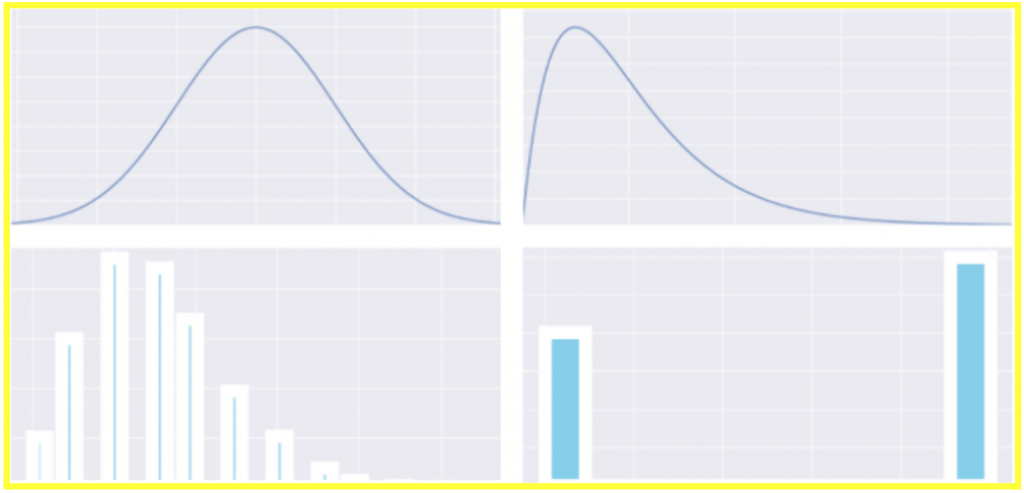Edition: June 23rd, 2021
Curated by the Knowledge Team of ICS Career GPS

Article by Terence Shin, published in towardsdatascience.com
Probability distributions seem daunting, partly because there are so many of them and they all have such unfamiliar names. They’re actually very simple concepts to understand when you strip away all of the math behind them.
Rather than getting into the mathematical side of things, we will go over the most fundamental and essential probability distributions.
First, you need to know a few terms:
- A probability distribution simply shows the probabilities of getting different outcomes.
- A discrete distribution is a distribution in which the values that the data can take on are countable.
- A continuous distribution on the other hand is a distribution in which the values that the data can take on are uncountable.
1. Normal Distribution
The normal distribution is arguably the most important distribution to know because many phenomena fit this distribution – IQs, heights of people, shoe size, birth weight, etc.
The normal distribution has the following properties:
- It has a symmetric bell shape
- The mean and median are equal and are both located at the center of the distribution
- ≈68% of the data falls within 1 standard deviation of the mean, ≈95% of the data falls within 2 standard deviations of the mean, and ≈99.7% of the data falls within 3 standard deviations of the mean.
The normal distribution is also an integral part of statistics, as it is the basis of several statistical inference techniques, including linear regression, confidence intervals, and hypothesis testing.
2. T-Distribution
The T-distribution is similar to the normal distribution but is generally shorter and has fatter tails. It is used instead of the normal distribution when the sample sizes are small.
One thing to note is that as the sample size increases, the T-distribution converges to the normal distribution.
3. Gamma Distribution
The Gamma distribution is used to predict the wait time until a future event occurs. It is useful when something has a natural minimum of 0. It’s also generalised distribution of the chi-squared distribution and the exponential distribution.
4. Chi-Squared Distribution
The chi-squared distribution is a particular case of the gamma distribution. As there’s a lot to the chi-squared distribution, there are several uses for it:
- It allows you to estimate confidence intervals for a population standard deviation
- It is the distribution of sample variances when the underlying distribution is normal
- You can test deviances of differences between expected and observed values
- You can conduct a chi-squared test
5. Uniform Distribution
The uniform distribution is really simple — each outcome has an equal probability. An example of this is rolling a die.
6. Bernoulli Distribution
In order to understand the Bernoulli Distribution, you first need to know what a Bernoulli trial is. A Bernoulli trial is a random experiment with only two possible outcomes, success or failure, where the probability of success is the same every time.
For example, flipping a coin can be represented by a Bernoulli distribution. Therefore, the Bernoulli distribution is a discrete distribution for one Bernoulli trial.
7. Binomial Distribution
Now that you understand the Bernoulli distribution, the binomial distribution simply represents multiple Bernoulli trials. Specifically, the binomial distribution is a discrete distribution that represents the probability of getting ‘x’ successes out of ‘n’ independent Bernoulli trials.
One interesting thing about the binomial distribution is that it converges to a normal distribution as n (# of Bernoulli trials) gets large.
8. Geometric Distribution
The geometric distribution is also related to the Bernoulli distribution, like the binomial distribution, except that it answers a slightly different question. The geometric distribution represents the probability of “how many trials are needed until your first success?”
You can also use the geometric distribution to find the probability of the number of Bernoulli(1-p) successes until failure. The geometric can also be used to check if an event is i.i.d if it fits the distribution.
9. Weibull Distribution
The Weibull distribution is like the geometric distribution, except it is a continuous distribution. Therefore, the Weibull distribution models the amount of time it takes for something to fail or the time between failures.
10. Poisson Distribution
The Poisson distribution is a discrete distribution that represents how many times an event is likely to occur within a specific time period. The Poisson distribution is most commonly used in queuing theory, which answers questions along the lines of “how many customers are likely to come (queue) within a given period of time?”.
11. Exponential Distribution
The exponential distribution is closely related to the Poisson distribution. If arrivals are distributed Poisson, then the time between arrivals has the exponential distribution.
(Disclaimer: The opinions expressed in the article mentioned above are those of the author(s). They do not purport to reflect the opinions or views of ICS Career GPS or its staff.)



